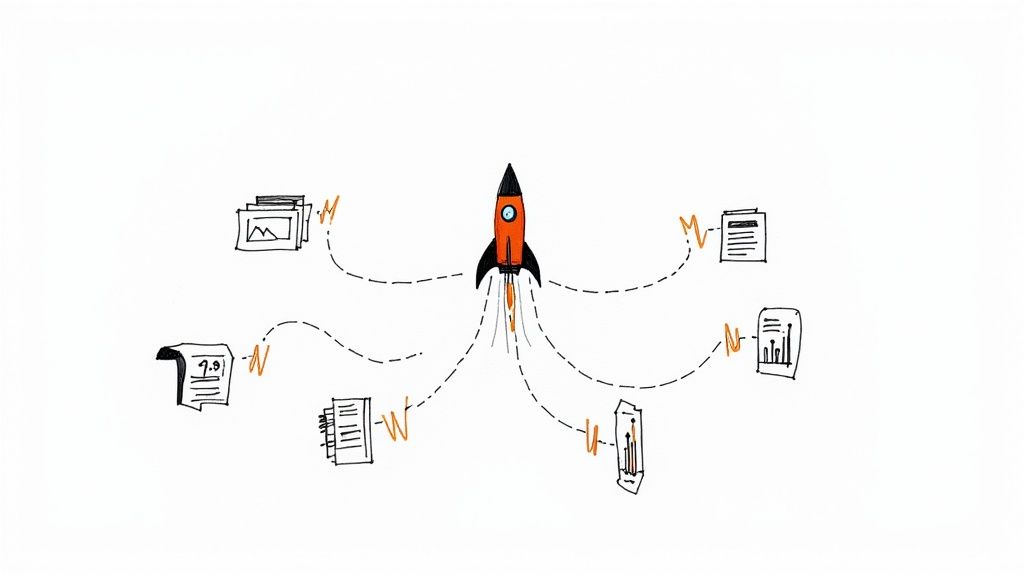Why Most Cold Email Follow Ups Get Ignored

Let's be real, most cold email follow-up sequences feel like they were written by robots. Generic, repetitive, and all about the sender, not the person receiving them. Think about your own inbox. How many "Just checking in" emails do you instantly delete? Probably tons.
This is because most follow-ups miss the most important ingredient: value. Instead of bringing something new to the table, they just repeat the first pitch.
This whole idea of "reminding" prospects you exist can actually backfire. It makes your follow-up feel like an interruption, yet another thing vying for their attention. Decision-makers are drowning in emails. Unless yours offers something genuinely helpful, it’s going straight to the trash.
Imagine getting a follow-up that just repeats the initial offer. Now imagine one with a helpful industry article or a personalized tip about a problem they've mentioned. Which are you more likely to open?
The average response rate for cold emails is pretty low, usually between 1% and 5%, depending on how relevant and trustworthy you seem. Follow-ups can bump those numbers up, but only if they fix core problems like relevance. A whopping 71% of decision-makers say irrelevant content is the main reason they ignore cold emails. Impersonal vibes and lack of trust are close behind. Want to dive deeper into cold email response rates? Check out this helpful resource: Learn more about cold email response rates. It underscores how vital it is to make every follow-up count. If you’re looking for tools to help write compelling emails, this AI Writing Assistant Guide might give you some ideas.
You need a mindset shift. Stop thinking of follow-ups as reminders. Start thinking of them as chances to deliver progressive value. Each email should build on the last, offering fresh insights, resources, or perspectives that actually benefit the prospect. This changes your follow-up from an annoyance into a valuable interaction.
Timing Your Follow Ups Like a Sales Pro

Forget that old "three-day rule" for cold email follow-up sequences. It’s not about sticking to a rigid schedule. It’s about finding your prospect's groove.
Think about it. If you're trying to connect with busy executives, Tuesday at 10 AM is probably a terrible time. They're likely buried in meetings. A Friday afternoon follow-up, however, might find them in a quieter moment, more open to your message.
Tailoring Your Timing
This means customizing your cold email follow-up timing to your specific audience. Consider their industry, their job role, and even their company's usual work week. For instance, if you’re targeting a retail business, their peak times are probably weekends and holidays. You'll probably see better engagement during their off-season.
Also, think about industry events or business cycles. Sending a follow-up right after a relevant industry conference can dramatically increase your chances of getting noticed.
The Power of Persistence
Follow-up emails are crucial for converting prospects, especially when that first email gets buried. A surprising 44% of sales reps give up after just one email, but 80% of deals actually close after the fifth interaction.
Effective follow-up strategies involve sending messages at intervals—maybe two to three days after the initial email, then four to five, and then again after seven. Discover more insights on cold email follow-ups. This highlights the importance of strategic timing. Want to make things easier? Check out our guide on cold email automation.
The Art of Strategic Patience
Sometimes, the smartest move isn’t to follow up right away. Instead, wait for a trigger event—a company announcement, a change in the market—something that makes your message timely and relevant. This requires careful attention and a solid understanding of your prospect’s world.
Creating Follow Ups That Actually Add Value

The line between a helpful follow-up and an annoying one isn't about frequency; it's about value. Think of each follow-up as a mini-consult, offering something the prospect genuinely wants. This is what I call progressive value delivery: each email builds upon the last, while still standing on its own.
Think of it this way: your first follow-up might share a relevant industry article. Your second might offer a quick tip related to a problem they've mentioned on social media. This shows you're not just blasting emails—you're actually paying attention and trying to help. You might find this interesting: email follow-up information.
Researching for Relevance
Generic templates just don't work. The best follow-up campaigns are built on solid research. Take the time to understand your prospect's company, their role, and the challenges they face. Trust me, even the smallest details can make a huge difference.
Their industry matters, too. Let's say you're selling marketing software to a SaaS company. Sharing a recent SaaS marketing trends study instantly shows you know your stuff, positioning you as a valuable resource.
Leveraging Timely Triggers
Tying your follow-up to current events, company news, or even something as simple as the season can make it feel incredibly relevant. Did they just launch a new product? Congratulate them! Suggest ways your service could support their growth. It's all about being engaged with their world.
This approach takes a generic follow-up and turns it into a timely, valuable interaction. Suddenly, you’re not just another salesperson – you’re someone who understands their current situation. Addressing those unspoken objections and offering personalized insights? That's the key to truly connecting.
Building Follow Up Sequences That Convert
Most people see cold email follow-ups as one-off shots in the dark. But the real magic happens when you create a sequence. It's all about understanding your prospect's journey. Think of it as guiding them from first glance, to a spark of interest, to finally taking action. It's a conversation, not a lecture.

This chart shows how response rates shift based on the days between follow-ups. Notice the sweet spot around day five? This isn't a hard and fast rule, but it does show the power of timing your emails strategically instead of bombarding inboxes.
Varying Your Approach
Your first follow-up could be a quick "checking in" message. The second might offer a valuable piece of industry knowledge. Then, for your third, try a strategic "retreat." Thank them for their time and offer to circle back later. This approach builds curiosity and shows respect for their busy schedules.
The Power of the Sequence
I've seen firsthand how effective sequences can build momentum without overwhelming decision-makers. The key is variety, both in content and timing. Watch for engagement signals. If a prospect opens your first two emails but doesn't reply, give them a bit more breathing room before the next one. Persistence matters, but so does reading the situation.
Follow-ups make a huge difference. Studies show they drastically increase average reply rates. For example, Hunter.io found that campaigns with follow-ups see a 4.9% reply rate, compared to a measly 3% without. Learn more about the impact of follow-up emails on cold email campaigns. And once you've got a sequence nailed down, tools that automate outbound calls can supercharge your outreach even further.
Let's look at some data I've collected comparing different follow-up strategies:
Follow-Up Email Performance Comparison
This table highlights how different strategies yield different results. While the "Value-Add" approach gets a good initial response, the "Strategic Retreat" can surprisingly lead to higher conversions down the line. The "Last Chance" is a Hail Mary – it doesn't always work, but it can sometimes rekindle a fading conversation.
Graceful Exit Strategies
Knowing when to step back is as important as knowing when to push forward. A graceful exit leaves the door open for future connections without burning bridges. Offer a helpful resource, thank them for their time, or suggest connecting again down the road. It's all about being professional and respectful of their inbox.
Reading the Signals: When to Push and When to Pull Back
Knowing when not to send a follow-up cold email is just as crucial as knowing when to send one. It's all about picking up on those subtle cues and figuring out what your prospect's silence actually means. Are they genuinely buried under a mountain of work? Politely brushing you off? Or maybe, just maybe, are they actually starting to warm up to your message?
I’ve seen salespeople absolutely nail this delicate balance, and the secret is in how they interpret the different types of silence. A delayed response isn't always a "no." Sometimes it's a "not right now." This resource on following up on cold email might give you some extra perspective.
Recognizing the Signs
Some warning signs scream that it's time to completely rethink your strategy. An out-of-office reply mentioning an extended leave? That's a pretty clear sign to back off. Multiple unopened emails also hint that they're not engaged.
But there are positive signs too! A LinkedIn connection request after your email could mean they're open to further communication. A neutral response – a short acknowledgment without a firm yes or no – requires a bit of strategic patience.
The Strategic Pause
Learning to strategically pause your outreach can actually spark curiosity. Instead of bombarding them with emails, try waiting for a relevant trigger event. A company announcement, a market shift, anything that makes your follow-up feel timely and not out of the blue.
Sometimes, the best follow-up is no follow-up… for now. It's about choosing the right moment to re-engage. Testing the waters without being aggressive is a real skill. Try sharing a valuable resource related to their industry with a simple note like, "Thought this might be helpful." This shows your expertise and reminds them of your value without coming across as pushy. You get to gauge their interest without risking your reputation.
Customizing Your Approach for Different Prospects
Not all prospects are created equal. A CEO worried about quarterly earnings isn't going to react the same way to a cold email as a manager dealing with day-to-day operations. Your follow-up strategy needs to be just as adaptable.
Thinking about those differences is key before you even hit send on that first follow-up.
Understanding Your Prospect
Before you craft your follow-up, consider your prospect's persona. Are they data-driven? Do they prefer short, sweet messages, or do they appreciate a deep dive? This impacts how you write.
Company size also plays a role. Larger companies often have longer sales cycles with multiple decision-makers. You might need to create several unique follow-ups, each tailored to the individuals involved. For some inspiration, check out these sales email templates.
Tailoring Your Strategy
Timing is everything. Senior executives might only be available during certain windows. Adjust your sending schedule accordingly. Don't waste a perfectly good email by sending it when it's likely to be buried.
Industry and company culture also influence responses. Do your homework. If a company prides itself on innovation, highlight the cutting-edge aspects of your product. If they're more traditional, emphasize stability and reliability. Know your audience.
Advanced Follow-Up Techniques
For complex sales, multi-threading—reaching out to multiple people within the same organization—can be a powerful tactic. Connect with different stakeholders, giving each person information relevant to their role. This demonstrates that you understand their specific pain points.
However, be strategic. Coordinate your outreach and personalize every follow-up. Avoid bombarding prospects with redundant information. Multi-threading done well shows you've done your homework, not that you're spamming everyone in their address book.
To help you visualize different approaches, take a look at the table below. It outlines tailored strategies based on prospect type:
To help you visualize different approaches, I've put together a table outlining some customized follow-up strategies:
Follow-Up Strategies by Prospect TypeCustomized follow-up approaches based on prospect characteristics and decision-making styles
This table gives you a starting point for tailoring your communication. Remember, these are general guidelines, and the most effective approach is always to personalize based on your specific prospect and their context.
The bottom line? Building genuine relationships, not just sending emails, is the name of the game. Understanding your prospect and adapting your follow-up strategy dramatically increases your chances of converting a cold lead into a warm opportunity.
Your Action Plan for Follow Up Success
So, we've covered strategy, timing, and writing compelling follow-up emails for your cold outreach. But how do you put it all together and build a system you can actually use? This isn't about theory – it's about getting results and hitting those sales targets.
Let's ditch the guessing games. Set up a system to track your response rates. Which subject lines are performing best? Which email templates are getting opened and clicked? Monitor everything so you can focus on what's working and drop what's not. If you're having trouble getting your emails delivered in the first place, our article on email deliverability might be helpful.
Next, get yourself organized. A messy follow-up schedule is a surefire way to miss opportunities. Use a CRM like HubSpot, a spreadsheet, or whatever tool you prefer, but create a system for your follow-up process. This will keep you on track and help you personalize your messages, even at scale. For more on nurturing customer relationships after that initial contact, check out this resource on Building Client Relationships.
Finally, remember that even with automation, personalization is key. Use your data to tailor your messages, but write like a human. Genuine connection makes a huge difference. And don't be afraid to experiment. The market changes, your prospects change, and your follow-up strategy should evolve too. Keep testing and refining to find what works best for you.
Want to supercharge your cold outreach and see real results? PlusVibe can help. Our AI-powered platform streamlines your entire cold email process, from creating personalized campaigns to automating follow-ups and providing in-depth performance tracking. Learn more and start your free trial at PlusVibe.














































.jpeg)


.png)























































